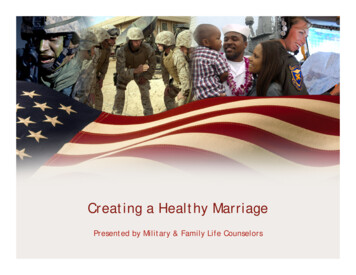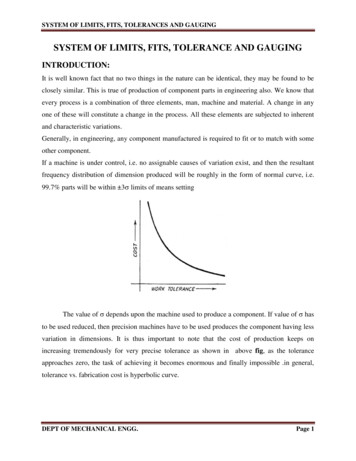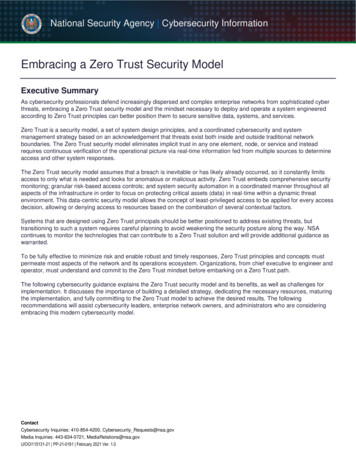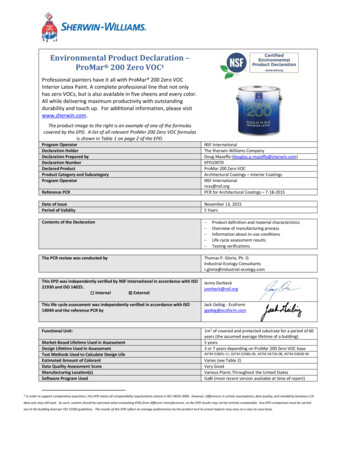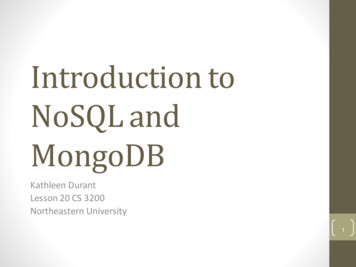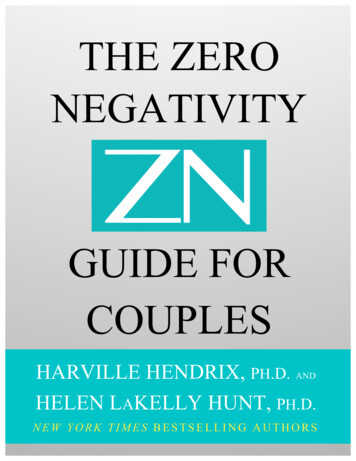
Transcription
THE ZERONEGATIVITYGUIDE FORCOUPLESHARVILLE HENDRIX, PH.D. ANDHELEN LAKELLY HUNT, PH.D.NEW YORK TIMES BESTSELLING AUTHORS
1THE ZERO NEGATIVITYGUIDE FOR COUPLESby Harville HendrixPh.D.and Helen LaKelly HuntPh.D.There is a lot of negativity happening in our society today. It almost seems likePandora’s Box was ripped open, and there’s an untethered freedom to hurl a barrageof angry, hurtful, and unfiltered words at other people. Many might want to blame themedia, politicians, or some sort of cultural shift. But, to us, what is reflected in societyis mirrored in our own psyches. What shows up on a macro level is an expression ofthe micro level. We can only be capable of a negative-free society if we can first becapable of a negative-free relationship at home.In our most intimate relationships, we start with expressions of unconditional love:doting behaviors, letters, text messages, and phone calls declaring our pledge, feelingpositively joyful with ourselves and the world. Yet, when we fall in love, we are notable to maintain that level of perfect love. Soon after, the ecstasy of love wanes. Forexample, we might begin to notice that Bob is slightly careful with money or that Joanis a bit opinionated. Before long, Bob is always stingy and Joan always has to have ither way.We call this stage – which naturally follows romance – the power struggle. And, justlike in our culture, when couples are in a power struggle, the full blame falls on theother: “It’s your fault!” (Conversely, “It’s never my fault!”) And we try to change,coerce, and/or threaten them to be “more like me.”
2The “Experts” Who Almost Didn’t Make ItWe, ourselves, are also victims and culprits of this blame game. After a decade ofmarriage, we found ourselves teetering on the edge of divorce. And, this was after ourbook, Getting the Love You Want, sold millions of copies, Harville appeared 17 timeson Oprah as a premier couples expert, and over 2,000 therapists worldwide weretrained in our techniques to save marriages!Of course, we blamed the other for the condition of our relationship. We kept tryingto make it work, sought out the top relationship therapists in New York City (a fewfired us, and one we fired). Not holding onto too much hope, we gave our relationshipone last try, committing to another three months to do everything we could to salvageour relationship.During this time of uncertainty, we were visiting a book store when we happened on abook about how astrology affects relationships. Just for fun, we opened to the pagewhere our two astrological signs intersected. Then we read, “You will destroy yourrelationship unless you stop the unrelenting negative scrutiny of each other.” We werestunned. And, then we laughed. We knew the book had gotten it right.For a time, we were quiet and separate as we turned our thoughts around thosewords. That sentence fell like a bombshell, because we knew it was true. The more wethought about it, the more we realized we had to stop what we now call the “invisibleabuse” of belittling, negating, and undermining each other. We started by trying to bemore aware of what we were saying, what words we used. We worked out a plan tomonitor ourselves for negative behaviors, and negative thinking.
3At the beginning, as we tried to stop, we grew to realize our negativity seemed tohave a life of its own. It didn’t take much. A critical comment. A moment ofimpatience. A raised tone of voice. Sometimes, we would degenerate into loudarguments. Whenever we descended into negativity, our pain was acute. Negativitynever got us what we wanted. It always made matters worse.When we cooled off, we realized that it would take us hours or even days of repairwork to feel connected again. Eventually, it became clear as day that being negativewith each other was irrational, abusive, and counterproductive. We then realized wewere addicted to our negativity. We agreed that the only solution was to eliminate allforms of negativity once and for all. We pledged to be “Zero Negative” and decidedto go cold turkey.What is Negativity?What do we mean by negativity? Negativity is any thought, word, or deed that tellsyour partner: “You’re not okay when you think what you think or act the way that youact.” In essence, you are rejecting your partner’s “otherness.” We sometimes feel theneed to negate our partners when they do or say something that makes usuncomfortable. Usually, they are just being themselves. But from our point of view,they are threatening an image that we have of them, or they are failing to meet anunspoken need of our own.Typically, negativity makes its first appearance in a love relationship as denial: “I can’tbelieve you did that!” “You never said anything like that before!” “You can’t reallymean that.” “You’re not that kind of person.” The fact that your partner is a separate
4individual with wishes and needs different from yours is starting to dawn on you, andyou feel threatened. Your denial is a desperate ploy to hold on to your illusions.When your partner continues to depart from your projected image, the tendency is tobring out the big guns, one by one. Your arsenal includes shame, blame, criticism,invasiveness, avoidance, and, finally, blanket condemnation. First you shame. “How doyou think that feels?!” “You ought to be ashamed by the way you treated my friend.”In essence, you are trying to make your partner feel guilty for being who he or she is.Then you blame. “You were late, and that made me really upset. That’s why I haven’tbeen talking to you.” “If you hadn’t been so angry, we would have been able to settlethe matter in very little time.” When you blame, you put all the burden of yourfrustrations on your partner.Next, you begin to criticize your partner’s character traits in addition to his or herunacceptable behaviors: “You are so insensitive.” “You are untrustworthy.” “Youalways think about yourself first.” You are attempting to paint your partner not only asthe source of all your frustration but to make them into a “bad” person as well.A more subtle ploy is to invade your partner’s psyche and act as if you had x-ray vision:“That is not what you really think.” “The reason you’re so crabby is that you areobsessing too much about work.” “If you’ll just listen to me, I’ll tell you what you needto do.”The final weapon is absolutism: “You never listen to me!” “You always leave the hardwork for me.” “That’s just the way you are.” “Every time I make a simple suggestion,you have a big fit.”
5It’s no wonder that our partners feel depressed, stay late at work, drink too much,and/or don’t want to make love, or stay up late by themselves. Being with us is not asafe place to be. They experience being chopped up into little pieces, dissected, andrejected. This is a form of emotional annihilation. At the base level, it expressescontempt. No one – and no relationship – can be healthy in such a toxic environment.To get the love we want, we need to eliminate negativity in all its forms.One question we are often asked is whether “all negativity is bad.” And ourunequivocal answer is, “Yes!” No relationship can grow or deepen or survive innegativity no matter what form it takes. Negative words inflict emotional injury. Youcan call it sarcasm or humor, or whatever excuse you make (“I was only kidding!”), butit is abuse. If you find yourself saying, “Can’t you take a joke?” or, “I was onlykidding,” or “I’m just offering constructive criticism,” chances are you are harmingyour relationship. And criticism may not always take the form of words. It can be atouch, a glare, an eye roll, or two hands thrown up in the air. However it comes out,the message is that one person is superior and the other inferior. One person is up,the other person is down. It's an unpleasant feeling for the person down, a feeling thathas its roots in the “old brain” that is responsible for warning us from danger.Harsh words can induce a feeling of anxiety. Anxiety, at its roots, is the nervous systemresponding to a stimulus of danger -- the fight or flight response. And even negativethoughts can provoke a defensive reaction. Because we all have internal radar thatmakes us astute at picking up nonverbal cues from our partners, we can detect thesubtle changes in posture and expression that accompany negative thoughts. Theresponse of the criticized person also takes one of these forms: They may slink away
6(“the silent treatment”), play dead in a submissive posture, or take on the accuser byfighting back.There’s another good reason to that negativity is bad: the negativity that we expresstoward our partners (or relatives, friends, even strangers) comes back like aboomerang and affects us as well. That’s because the old brain does not knowwhether the negativity is being directed outward or inward. This theory has beenbacked up by studies showing that when one person yells at another, the personbeing yelled at produces more of the stress hormone cortisol. That’s to be expected.But, perhaps more interestingly, the same increase in cortisol is seen in the angryperson as well. One could say that any negativity that we direct toward others is aform of self-abuse.We teach couples that in order to have the relationship of their dreams, we need to beresponsible for how we treat each other. There is a responsibility of how we talk, look,share, treat one another. No shame, blame or criticism – ever. Whether criticism isphrased in a gentle way or a cruel way, it comes from the same place of judgment.Unconsciously, the critic believes that their opinion is the "only" correct one. The wayhe or she looks at the world is the only reasonable way to see it, and if the partner, onsome level, differs, they must have no sense, or taste -- in fact, they're crazy! The otherperson, in a way, ceases to be a person, and is instead an object to be molded into thecritic's (sane) way of looking at the world.Back to Our StoryTo enforce our decision to eliminate all forms of negativity from our relationship, wepurchased a calendar, put it in our bedroom wall, and spent a few minutes every
7evening evaluating whether either of us experienced negativity from the other. If onedid, we would draw a frowny face on the calendar. If we were successful in gettingthrough the day without experiencing negativity, the day would receive a smiley face.For a while, our calendar had more frowny faces than smiley ones but this observationtrained us to be more intentional and affirming.It took time, but we pledged that if we didn’t have something positive to say, wewouldn’t say anything at all. But, then we experienced a strange awkwardness. Wewent silent. We would go on a date night vowing there would be no negativity, andwe had nothing to say. The place where all that negativity had lived was now quiet,but we were still not close. We were acutely aware at the distance between us.Filling in the GapsTo fill in the empty space, we designed another experiment. We began a ritual ofappreciations. We pledged to end each day with the expression of three appreciationsof each other. And we could not use the same three the next day.Having to express three new appreciations each day forced us to observe each otherto find traits and behaviors we liked and to put them into words. We both learnednegativity in our families, as they learned it from theirs. We unlearned it in that nightlyritual of ten minutes or so of expressing love in a new way, through appreciation andgratitude. “I appreciate the fact that you were an attentive listener to me last night,even though you were very tired.” “You gave me such great feedback on the letter Iwas writing to the board members.” “I loved it when you took the time to go for awalk with me, even though you were busy.”
8Each positive statement had to be unique and specific, and we couldn’t repeatanything we had said before. A hidden benefit of this rule was that we discoveredmany wonderful things about each other that we had been overlooking when we wereupset.We also discovered the reality that it is hard to be completely free of negativity. Ourchildhood, our culture, our “freeze, flight, or fight” evolutionary responses inevitablymakes us susceptible for being a provider and recipient of negativity. Of course, weourselves have fallen many times – even with our backgrounds in psychotherapy andour pledge to save our marriage. But, out of that experience, we developed ways toquickly repair the relationship which we now call the Reconnecting Process. (You willlearn this process at the end of this guide.) We began to be more forgiving of eachother’s “slip ups” and more committed to, not only pledging Zero Negativity, butmore importantly, pledging to reconnect when either of us experienced a put-down.The Results of Going Zero NegativeEliminating negativity is the most powerful way to transform your relationship. Indeed,it is the foundation for lasting love. Ultimately, though, all committed relationshipscontain a seed, no matter how small it may seem, of meaningful love and affection.Even if the approach of Zero Negativity leads to, essentially, a vow of silence,eventually the mantle of fear will dissipate and both parties will find the warmthtoward each other that they once had. They will find things to say that are neutral andeventually positive. As the activated fear in the old brain diminishes, both people willbegin to feel safe with one another, which is the primary and most importantfoundation of a healthy relationship.
9We now think of negativity as an emotional disease on the order of cancer. It ispervasively destructive and ultimately kills the relationship. But unlike cancer,negativity can be stopped. You can decide now to stop all negativity. Act on thatdecision and everything will change. To be blunt: negativity is invisible abuse and is anaddiction of the human race. When you eliminate this invisible abuse in your primaryrelationship, then you eliminate it in your relationships with your children, your friends,and the broader world. You become a person of peace!Happily Ever AfterEventually, we overcame most of our problems by using the exercises we actuallytaught to couples. Imagine that – we began to practice what we preached. Wepracticed listening and sharing responsibly. We became more thoughtful lovers andmade frequent expressions of love and gratitude through words, notes, gifts, andcaring gestures. Our statements of appreciation increased the flow of love betweenus. Every time we told each other something we genuinely admired about the other,we were deeply moved—each and every time.Our admiration gradually evolved into a state of “chronic adoration.” (A muchdifferent – and preferred - experience than our chronic criticism!) Over time, welearned how to work together harmoniously as partners. There were moments whenwe felt deep love and empathy for each other. Removing all negativity from ourrelationship was the final turning point for us. We found our way back to each other.We experienced a level of emotional safety with each other that we had never knownbefore, and our hearts opened to a deeper experience of love. We fell in love again.But this time it was different; it was better. Passion returned and we began to feel fullyalive and joyful.
10We felt so blessed by what we had achieved that we held two recommitmentceremonies, the first of which was at our annual conference with our colleagues in theImago community. We wrote new vows of commitment that were in keeping with allwe had learned and recited them before the group. Afterwards, our colleagues liftedus high in the air and paraded us around the room while everyone sang and danced.Two months later, we held a New Year’s Eve ceremony in the majestic RiversideChurch in New York City, where we were members. Our pastor led us through ourvows in front of 250 family members and friends, after which we retired to a grand hallon the Hudson River where we ate and danced and were roasted and toasted untilmidnight. When the fireworks exploded, we felt like they were just for us. We includedall the celebrants of the New Year as witnesses to our love and our future.Finally, we were giving each other the respect we both wanted on a continual basis.What’s more, we found it easier and easier to do. Our relationship had become such asacred place for us that we had no desire to violate it. To slip back into old behaviorsbecame unthinkable.Take the Zero Negativity ChallengeWhen people tell us how hard it is to stop being negative, we remind them it’s likefirst learning to ski. We can’t imagine going down the slope with our feet turnedinward. When we ask, “Why?” the instructor answers, “So you won’t die.” It’s thesame answer for eliminating negativity. You have to learn how to stop, or yourrelationship will die.
11That said, a relationship without one person being able to express a concern, is also anunhealthy place. Suppressed thoughts and feelings lead to passive-aggressivebehavior, or to the gradual dissolution of affection for one another.The path out of this relational trap is to first take on an approach of Zero Negativity:for both parties to commit absolutely to refraining from put downs, negativecomments and behaviors. While Zero Negativity does mean refraining from all putdowns, negative comments and behaviors, it does not mean we cannot express ournegative feelings or frustrations but we can share them in an intentional, responsibleway. The task may seem daunting, but the rewards are great. As negativity recedes,goodwill rushes in to fill the void.Without conscious effort, you find yourself focusing on your partner’s admirablequalities, much as you did during courtship. Only this time, you have the insights andtools you need to sustain your regard. Meanwhile, your partner will also be seeing youin a much more positive light, and you will both thrive in its warm glow. Eventually, asacred space will well up between you, one that both of you want to nurture andprotect. With conflict removed, connection will deepen and passion will flow.We challenge you to give it a try -- not a word, not a comment, not a thought, not aglance in a negative direction. Ask your partner to take the Zero Negativity Challenge.You will be amazed at the results.Tips for Going Zero Negative1. Self-Reflect: Keep in mind that the goal is not to repress the feelings behind ournegative thoughts and behaviors—that would only add to our store of pent-up
12emotions—but rather to bring them out into the open and see them for what theyreally are: a warning sign that some aspect of the relationship needs work. One of thebest ways to start solving a relationship problem is to look at your own contribution:“Here I am, having critical thoughts about my partner again. What does this say aboutme? What am I doing or not doing right now that is feeding my negative attitude?”2. Start with an achievable goal: We remind couples to start with small goals.For couples taking our workshop, we ask them to pledge to Zero Negativity for theremainder of our weekend time together. For others, we encourage taking a 30-dayZero Negativity Challenge. For others still, even a 24-hour commitment can be astretch and all they can commit to at the time. Once you build up small successes, youcan commit to longer periods of time.3. Move from “You messages” to “I messages”: When we are frustrated, it’seasy to move into negativity with “you messages” (you always, you never, you are suchan &#%!@?!) To help us move away from disparaging language (that provokes areaction), we teach couples to use “I messages” (“I feel ,” “I experience ”) Thishelps you take responsibility for your feelings and also help your partner “hear” thefrustration rather than move into a defensive stance.4. Learn Ways to Reconnect: Signing the Zero Negativity Pledge means that youagree to refrain from any “put downs” during your 30-day commitment. It does notmean that you cannot express your needs and deal with your issues. On the contrary,it means that without the contamination of negative exchanges, you will be able todeal with your issues in a healthier way. It’s what we say and how we say it. It's a rulethat's easy to remember but may be difficult to follow at first. In time, you'll begin tonotice all the ways you were being unconsciously critical -- making jokes at the other'sexpense, speaking negatively about them to others, thinking passive aggressivethoughts. This awareness itself can motivate change.
135. Assess Your Relationship: Keep in mind that the pledge is to keep yourrelationship free of negativity. You will be assessing your relationship, not each other.In addition, what matters is if one partner experienced negativity from the other –regardless of whether that was the intention.Zero Negativity Challenge InstructionsThe purpose of this challenge is to remove all negativity (criticism, shame, or blame)from your relationship. Follow these instructions:1. With your partner, read out loud together the Zero Negativity Pledge on the nextpage and agree to commit to Zero Negativity for 30-Days by signing the pledge. (Ifyou cannot commit to 30 days, then mutually agree a time a period of time.)2. Using a monthly calendar (or using the blank one provided in this guide), place thecalendar in a place where you can see it, like your bathroom mirror. At the end of eachday, review with your partner whether your relationship got a “negative” that day. IfYES, draw a “frowning face” on the day. If NO, draw a “smiley face” on the day.(Remember, you are accessing your relationship as a whole, not each other.)3. Read the Reconnecting Process (page x) and discuss ways to quickly repair andreconnect whenever you experience a put-down.4. When you have successful completed the challenge, keep renewing the challengefor a period of time until Zero Negativity is a condition of your relationship.
14THE ZERO NEGATIVITY PLEDGEWe understand that “negativity” is any transaction that ruptures ourconnection, whether intentional or accidental.We pledge to make our relationship a Zone of Zero Negativity for 30days. To that end we pledge to avoid any transactions that could beexperienced as a “put-down,” thus rupturing our connection.If we have a frustration, we will change it into a request and ask for whatwe want without criticism.If we experience a rupture, we will send a gentle signal (bing, ouch, oops,wow!) to communicate that we have experienced a “put-down,” and thenbegin repairing the rupture be using the Reconnecting Process.We pledge to gift each other with three appreciations each day, nomatter what!Signed:Signed:Date:
15THE RECONNECTING PROCESSOkay, now that you’re taking the pledge, here are some options you can considerif you experience a put-down:1. If you experience a put-down, communicate that to your partner with a gentlesignal (bing, ouch, wow, oops!).2. Then select a behavior that would restore the connection for you and engageyour partner in the process until you feel connected.3. There are various options to help reconnect: Ask for a RE-DO. Take time out, start over, and re-do the transaction. Model for your partner how s/he might RE-SEND the message so it doesn’tproduce a “put down.” Offer a RE-CONNECTING behavior, a single behavior like an apology,flowers, or a hug. Create your own reconnecting process.4. Conclude with an appreciation:What repairs a “put down” for me:What repairs a “put down” for my partner:Remember:The sign of a thriving relationship is how quickly you can reconnect!
16
17Create the Marriage of Your DreamsOver 4 million copies sold! Getting the Love You W ant is the NewYork Times bestselling classic that has helped millions of couples attainmore loving relationships and experiences these results: Develop understanding and compassion for each other.Experience more joy together and feel a closer bond.Rekindle deeper levels of romance and excitement.Eliminate negativity from daily interactions.Purchase from Am azon: http://am zn.to/2EO m m ltPurchase from Barnes & Noble: http://bit.ly/2CflIM 4Do you have a nagging feeling that your relationship could be better?Maybe you’re in a job transition, raising a child, or experiencing an emptynest. Or, you might be in the middle of a full-blown conflict.The Space Between unveils the secret to experiencing the joy andwonder that belongs to every human being. Harville Hendrix and HelenLaKelly Hunt explain how the “space between” two people determinesthe quality of your relationship. And, the quality of your relationshipdetermines the quality of your lives.Purchase today at Am azon: http://am zn.to/2oqofurPurchase today at Barnes & Noble: http://bit.ly/2ChN 3N xIn M aking M arriage Sim ple, Harville Hendrix and Helen LaKellyHunt, share 10 essential truths they've learned to create a successfuland satisfying relationship. Marriage is never easy, and a number ofyears ago, Harville and Helen found themselves on the brink of divorce.So, they put themselves back through the exercises they’d coached somany other couples through, saving their marriage, and helping themachieve a true partnership. Written with humor, compassion, andhonesty, Making Marriage Simple is the blueprint to create a stronger,more satisfying partnership in today's world.Purchase today at Am azon: http://am zn.to/2BPbgK7Purchase today at Barnes & Noble: http://bit.ly/2CktrbJ
18About the AuthorsHarville Hendrix Ph.D. is the New York Timesbestselling author of Getting the Love You Want: A Guidefor Couples, Keeping the Love You Find: A PersonalGuide, and with his wife, Helen LaKelly Hunt Ph.D.,Giving the Love that Heals: A Guide for Parents. Harvilleand Helen have written over 10 books with more than 3million copies sold. In addition, Harville has appeared on the Oprah Winfrey televisionprogram 17 times.Harville and Helen co-created Imago Relationship Therapy to promote thetransformation of couples and families and create relational cultures that supportuniversal equality. Together, they have developed a variety of resources to helpcouples, families, and educators strengthen their relationship knowledge and skills. Inaddition, they co-founded Imago Relationships International, a non-profit organizationthat has trained thousands of therapists in educators in 51 countries around the world.Harville has over 40 years experience working as a couple's therapist, educator, clinicaltrainer, and lecturer. His educational background includes graduate degrees fromUnion Theological Seminary (NY), the University of Chicago, and a former professor atSouthern Methodist University. In addition to being co-creator of Imago, Helen hasbeen inducted into the Women’s Hall of Fame for her support of the women’smovement.Harville and Helen have been married for 36 years and have six children and sixgrandchildren. They live in New York City and Dallas. For more information, visit:http://www.HarvilleandHelen.com
19CopyrightThe Zero Negativity Guide for CouplesCopyright 2018 by Harville Hendrix and Helen LaKelly HuntMaterial is this resource is excerpted from:Getting the Love You Want 1988, 2008 by Harville Hendrix and Helen LaKelly HuntPublished by Henry Holt & Co. New York.Conscious Relationships: Stop Abusing Your Partner with Negativity (from the series,“Discover Each Other and Deepen Your Connection”) by Harville Hendrix and Helen LaKelly HuntPublished on Healthy.NetZero Negativity 2012 by Harville Hendrix and Helen LaKelly HuntPublished on TheHuffingtonPost.comNo part of this material may be reproduced in any form or by any electronic ormechanical means, including information storage and retrieval systems, withoutwritten permission from the author, except for the use of brief quotations in a bookreview.All rights reserved.
book, Getting the Love You Want, sold millions of copies, Harville appeared 17 times on Oprah as a premier couples expert, and over 2,000 therapists worldwide were trained in our techn


